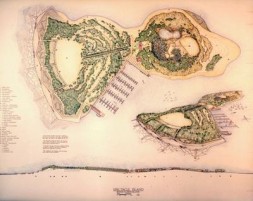RENEWABLE COLLECTIVE
Feminist ideologies favor working in collectives, embracing inclusiveness and developing a choral voice. During last century’s mid-1970s and early 80s I was actively involved in the creation of such structures with the aim of changing the dominant discourses in the art and architecture worlds. Although life-long friendships may be forged along the way, these collectives did not survive beyond the completion of the project that brought the group together. This is endemic to working in collectives because of the inevitable burnout from unremunerated work after hours for months at a time, including constant fund-raising and grant writing; and also because of the difficulty of carrying over the tensions that develop among members from one project to the next. There were a handful of notable exceptions to the short-lived collectives. One was Heresies, a feminist journal on art and politics in New York, where I was the only architect member of a founding group formed by artists, writers, art historians and filmmakers.
The genius of Heresies was to survive as long as it did – fifteen years and twenty six issues – because time is needed to influence the dominant discourse of any discipline or activity as deeply as Heresies did. How was this longevity possible? There was one hugely important factor: the renewability of the editorial collectives. The idea of the renewable collective, with each issue produced by a fresh team, followed from two decisions: first, that the issues would be thematic, and secondly that, save for the size and number of pages, there would be no “format” that the editorial collectives for each issue had to follow. Hence, each issue became a unique editorial project, breaking one of the cardinal rules of magazine publication, that of having an identifiable cover and logo for its name. This open-endedness and freedom of choice attracted many women who would not have committed to work beyond the specific issue of their interest. In addition, editorial decisions were reached democratically, with each member having to argue persuasively for the inclusion of a piece of writing or visual material with the rest of the editorial collective, very unlike the way magazines are usually run, reflecting the point of view of a single editor, supported by work of paid contributors.
The renewable collective amplified Heresies’ purpose, involving different people who had other connections. These contributed to expanding exponentially the roster of contributors and the readership. The continuity between issues was provided by the participation of at least one member of the founding collective in all issues. In time, there developed the need to have a (paid) editor from the founding collective to ensure that issues would come out more or less timely.
This created a model for a modus operandi that I believe could serve for any number of projects, then and now. In my architectural and academic practices, I adopted it in the organization of teams formed by my then current and former employees and students and professionals in other disciplines to work on about a dozen architecture and urban design competitions during last century’s 80s and 90s. Because these projects are usually rather complex, providing opportunities for a multitude of ideas to be expressed in the larger and smaller scales of each project, I sought to reproduce the dynamic of the democratic decision-making of the editorial collectives, encouraging the free discussion of ideas and the enthusiastic support of the best ones, replacing the individual attachment to an idea’s ownership for a sense of collective ownership. The awards we received were a validation of the method and a source of shared pride. And the experience allowed each participant not only to express her or his ideas, but also to see them contribute to a more complex and subtle whole. A similar approach seems to have worked for firms such as Apple or Google, and as my experience in Heresies and in my studio demonstrates, it can ensure the continuing vitality of any collective creative enterprise.

Competition for the recovery of Spectacle Island, Boston Harbor. Team formed by (alphabetically): Ray Beeler, Galen Cranz, Greg Doench, Jim Kocis, Mary Miss, Mark Robbins, Susana Torre, Sheldon Werdiger, Cassandra Wilday
reply? please send me an e-mail